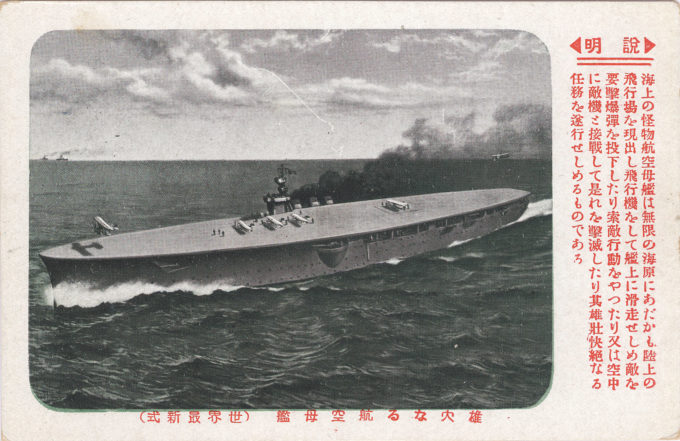
“Formidable aircraft carrier”, artist’s concept, c. 1935, bears a strong resemblance to the first Japanese carrier to incorporate a closed hurricane bow, Taiho, launched in 1944. The caption reads: “Aircraft carriers are monsters on the sea that appear as land-based runways on the boundless ocean floor, [its aircraft] gliding overhead to drop bombs on the enemy, conduct search-and-rescue operations, or engage enemy aircraft in mid-air to destroy them and carry out their heroic and exhilarating missions.”
See also:
Imperial Japanese Navy aircraft carrier “Akagi”, c. 1930.
Imperial Japanese Navy Fleet Commanders, 1936.
“The aircraft carrier Taihō [“Great Phoenix”] was among the most beautiful aircraft carriers built by Japan during WW2. Her distinct design, most notably the first to incorporate a closed hurricane bow, contributed to her aesthetic greatly.
“Taihō was approved for construction in the 1939 4th Supplementary Program. Her design was that of a modified Shōkaku. Under the Modified Fleet Replenishment Program of 1942, Taihō was to be the first of a new generation of Japanese aircraft carriers. Initially, it was envisioned she would carry 126 aircraft (with 30 of these in reserve). Later, this was pared down to 64, raised again to 78, reduced to 53 and, finally, carried 65 aircraft (at the time of her sinking in 1944).
“Built by Kawasaki at Kobe, she was laid down on 10 July 1941, launched almost two years later on 7 April 1943 and finally commissioned on 7 March 1944. Possessing heavy belt armor and featuring an armored flight deck (a first for any Japanese aircraft carrier), she represented a major departure from prior Japanese aircraft carrier design and was expected to not only survive multiple bomb, torpedo, or shell hits, but also continue fighting effectively afterwards.
“Taihō sank on 19 June 1944 during the Battle of the Philippine Sea due to design flaws and poor damage control after suffering a single torpedo hit from the American submarine USS Albacore, taking with it the lives of 1,650 men.”
– Wikipedia

